A Comparative Study of Allopathic and Alternative Medical Remedies
VerifiedAdded on 2020/03/23
|10
|2053
|127
Report
AI Summary
This report provides a comprehensive overview of various medical remedies, starting with definitions of key terms like analgesics, antihistamines, and antidepressants. It then delves into a comparative analysis of allopathic and alternative medicines, exploring their respective advantages and disadvantages. Allopathic medicine, the mainstream medical system, is examined for its use of pharmacologically active agents and surgical interventions, highlighting its ability to treat acute conditions and its reliance on research and development, while also noting concerns about side effects and treating symptoms rather than root causes. The report also explores alternative medicines, including homeopathy, Ayurveda, naturopathy, and osteopathy, detailing their principles, advantages, and disadvantages. The discussion includes an examination of the pharmaceutical classification system in New Zealand, outlining the different categories of drugs and the reasons for restrictions. The report uses various sources to support the information presented.
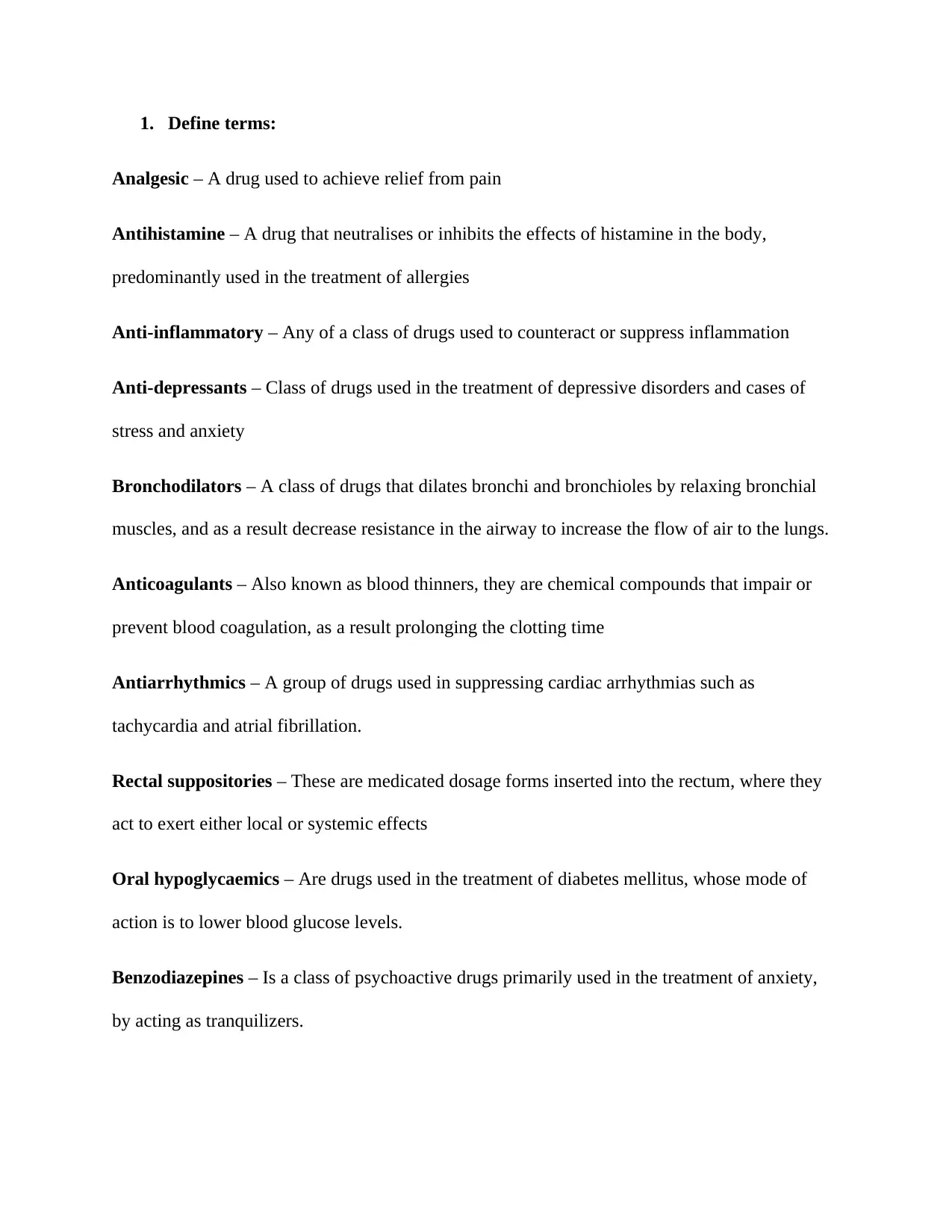
1. Define terms:
Analgesic – A drug used to achieve relief from pain
Antihistamine – A drug that neutralises or inhibits the effects of histamine in the body,
predominantly used in the treatment of allergies
Anti-inflammatory – Any of a class of drugs used to counteract or suppress inflammation
Anti-depressants – Class of drugs used in the treatment of depressive disorders and cases of
stress and anxiety
Bronchodilators – A class of drugs that dilates bronchi and bronchioles by relaxing bronchial
muscles, and as a result decrease resistance in the airway to increase the flow of air to the lungs.
Anticoagulants – Also known as blood thinners, they are chemical compounds that impair or
prevent blood coagulation, as a result prolonging the clotting time
Antiarrhythmics – A group of drugs used in suppressing cardiac arrhythmias such as
tachycardia and atrial fibrillation.
Rectal suppositories – These are medicated dosage forms inserted into the rectum, where they
act to exert either local or systemic effects
Oral hypoglycaemics – Are drugs used in the treatment of diabetes mellitus, whose mode of
action is to lower blood glucose levels.
Benzodiazepines – Is a class of psychoactive drugs primarily used in the treatment of anxiety,
by acting as tranquilizers.
Analgesic – A drug used to achieve relief from pain
Antihistamine – A drug that neutralises or inhibits the effects of histamine in the body,
predominantly used in the treatment of allergies
Anti-inflammatory – Any of a class of drugs used to counteract or suppress inflammation
Anti-depressants – Class of drugs used in the treatment of depressive disorders and cases of
stress and anxiety
Bronchodilators – A class of drugs that dilates bronchi and bronchioles by relaxing bronchial
muscles, and as a result decrease resistance in the airway to increase the flow of air to the lungs.
Anticoagulants – Also known as blood thinners, they are chemical compounds that impair or
prevent blood coagulation, as a result prolonging the clotting time
Antiarrhythmics – A group of drugs used in suppressing cardiac arrhythmias such as
tachycardia and atrial fibrillation.
Rectal suppositories – These are medicated dosage forms inserted into the rectum, where they
act to exert either local or systemic effects
Oral hypoglycaemics – Are drugs used in the treatment of diabetes mellitus, whose mode of
action is to lower blood glucose levels.
Benzodiazepines – Is a class of psychoactive drugs primarily used in the treatment of anxiety,
by acting as tranquilizers.
Paraphrase This Document
Need a fresh take? Get an instant paraphrase of this document with our AI Paraphraser
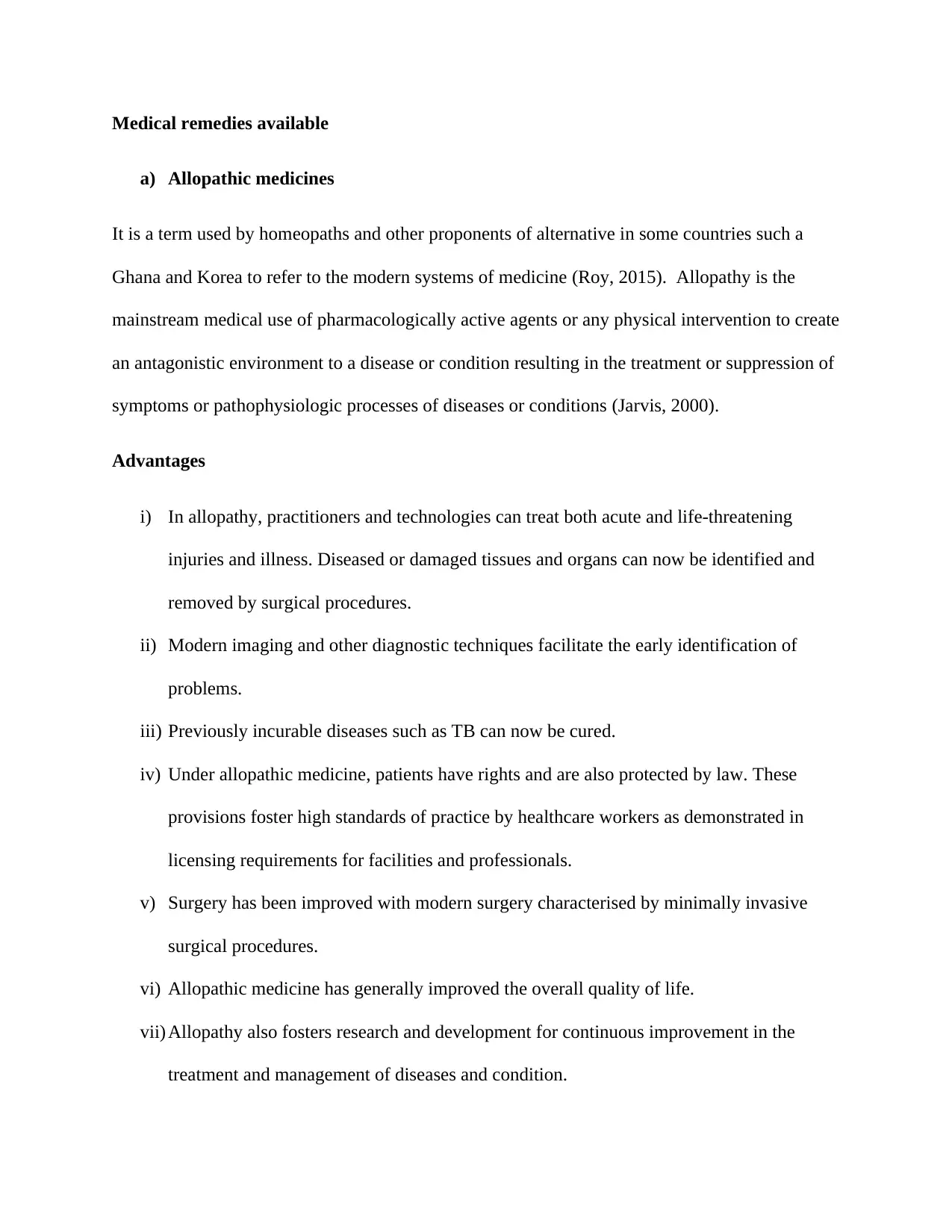
Medical remedies available
a) Allopathic medicines
It is a term used by homeopaths and other proponents of alternative in some countries such a
Ghana and Korea to refer to the modern systems of medicine (Roy, 2015). Allopathy is the
mainstream medical use of pharmacologically active agents or any physical intervention to create
an antagonistic environment to a disease or condition resulting in the treatment or suppression of
symptoms or pathophysiologic processes of diseases or conditions (Jarvis, 2000).
Advantages
i) In allopathy, practitioners and technologies can treat both acute and life-threatening
injuries and illness. Diseased or damaged tissues and organs can now be identified and
removed by surgical procedures.
ii) Modern imaging and other diagnostic techniques facilitate the early identification of
problems.
iii) Previously incurable diseases such as TB can now be cured.
iv) Under allopathic medicine, patients have rights and are also protected by law. These
provisions foster high standards of practice by healthcare workers as demonstrated in
licensing requirements for facilities and professionals.
v) Surgery has been improved with modern surgery characterised by minimally invasive
surgical procedures.
vi) Allopathic medicine has generally improved the overall quality of life.
vii) Allopathy also fosters research and development for continuous improvement in the
treatment and management of diseases and condition.
a) Allopathic medicines
It is a term used by homeopaths and other proponents of alternative in some countries such a
Ghana and Korea to refer to the modern systems of medicine (Roy, 2015). Allopathy is the
mainstream medical use of pharmacologically active agents or any physical intervention to create
an antagonistic environment to a disease or condition resulting in the treatment or suppression of
symptoms or pathophysiologic processes of diseases or conditions (Jarvis, 2000).
Advantages
i) In allopathy, practitioners and technologies can treat both acute and life-threatening
injuries and illness. Diseased or damaged tissues and organs can now be identified and
removed by surgical procedures.
ii) Modern imaging and other diagnostic techniques facilitate the early identification of
problems.
iii) Previously incurable diseases such as TB can now be cured.
iv) Under allopathic medicine, patients have rights and are also protected by law. These
provisions foster high standards of practice by healthcare workers as demonstrated in
licensing requirements for facilities and professionals.
v) Surgery has been improved with modern surgery characterised by minimally invasive
surgical procedures.
vi) Allopathic medicine has generally improved the overall quality of life.
vii) Allopathy also fosters research and development for continuous improvement in the
treatment and management of diseases and condition.
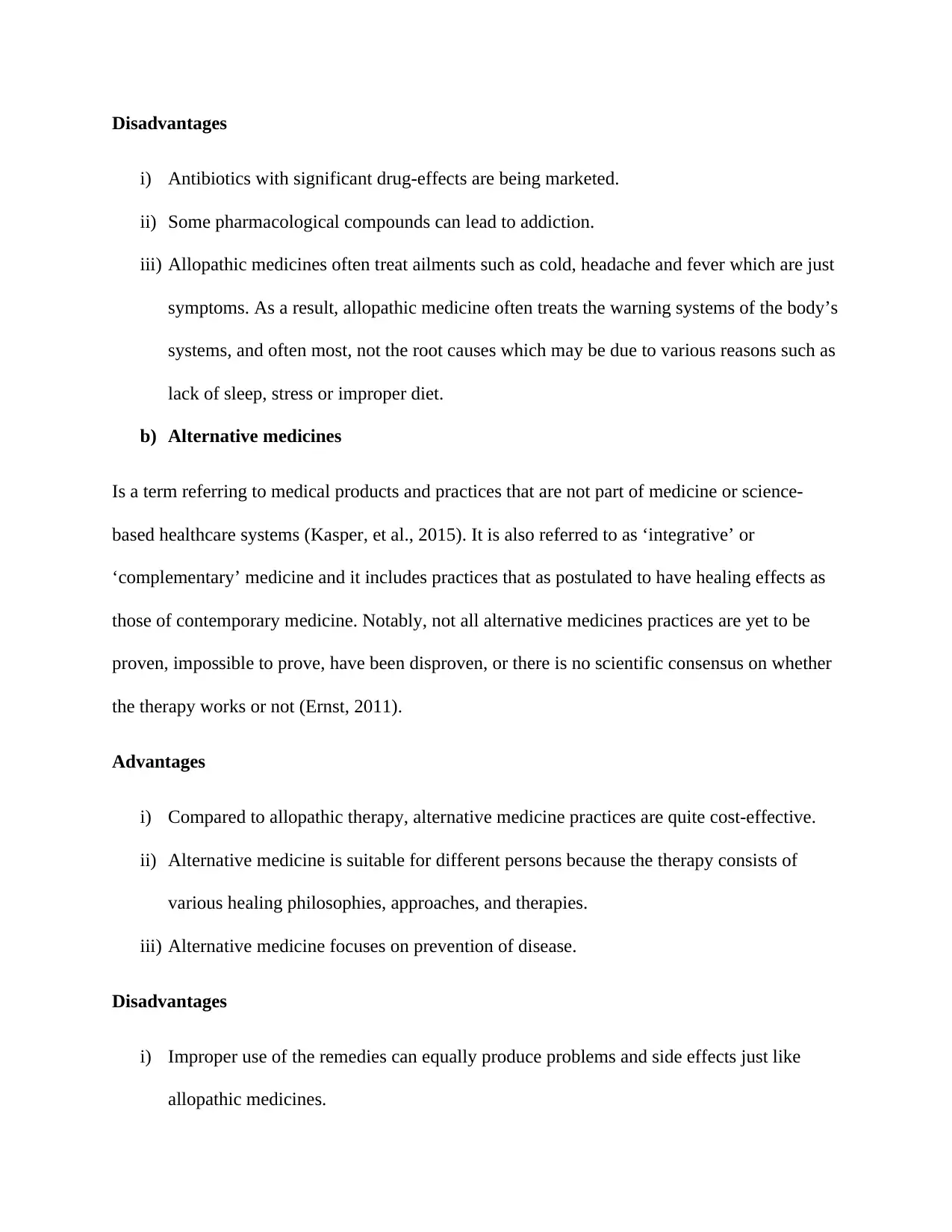
Disadvantages
i) Antibiotics with significant drug-effects are being marketed.
ii) Some pharmacological compounds can lead to addiction.
iii) Allopathic medicines often treat ailments such as cold, headache and fever which are just
symptoms. As a result, allopathic medicine often treats the warning systems of the body’s
systems, and often most, not the root causes which may be due to various reasons such as
lack of sleep, stress or improper diet.
b) Alternative medicines
Is a term referring to medical products and practices that are not part of medicine or science-
based healthcare systems (Kasper, et al., 2015). It is also referred to as ‘integrative’ or
‘complementary’ medicine and it includes practices that as postulated to have healing effects as
those of contemporary medicine. Notably, not all alternative medicines practices are yet to be
proven, impossible to prove, have been disproven, or there is no scientific consensus on whether
the therapy works or not (Ernst, 2011).
Advantages
i) Compared to allopathic therapy, alternative medicine practices are quite cost-effective.
ii) Alternative medicine is suitable for different persons because the therapy consists of
various healing philosophies, approaches, and therapies.
iii) Alternative medicine focuses on prevention of disease.
Disadvantages
i) Improper use of the remedies can equally produce problems and side effects just like
allopathic medicines.
i) Antibiotics with significant drug-effects are being marketed.
ii) Some pharmacological compounds can lead to addiction.
iii) Allopathic medicines often treat ailments such as cold, headache and fever which are just
symptoms. As a result, allopathic medicine often treats the warning systems of the body’s
systems, and often most, not the root causes which may be due to various reasons such as
lack of sleep, stress or improper diet.
b) Alternative medicines
Is a term referring to medical products and practices that are not part of medicine or science-
based healthcare systems (Kasper, et al., 2015). It is also referred to as ‘integrative’ or
‘complementary’ medicine and it includes practices that as postulated to have healing effects as
those of contemporary medicine. Notably, not all alternative medicines practices are yet to be
proven, impossible to prove, have been disproven, or there is no scientific consensus on whether
the therapy works or not (Ernst, 2011).
Advantages
i) Compared to allopathic therapy, alternative medicine practices are quite cost-effective.
ii) Alternative medicine is suitable for different persons because the therapy consists of
various healing philosophies, approaches, and therapies.
iii) Alternative medicine focuses on prevention of disease.
Disadvantages
i) Improper use of the remedies can equally produce problems and side effects just like
allopathic medicines.
⊘ This is a preview!⊘
Do you want full access?
Subscribe today to unlock all pages.

Trusted by 1+ million students worldwide
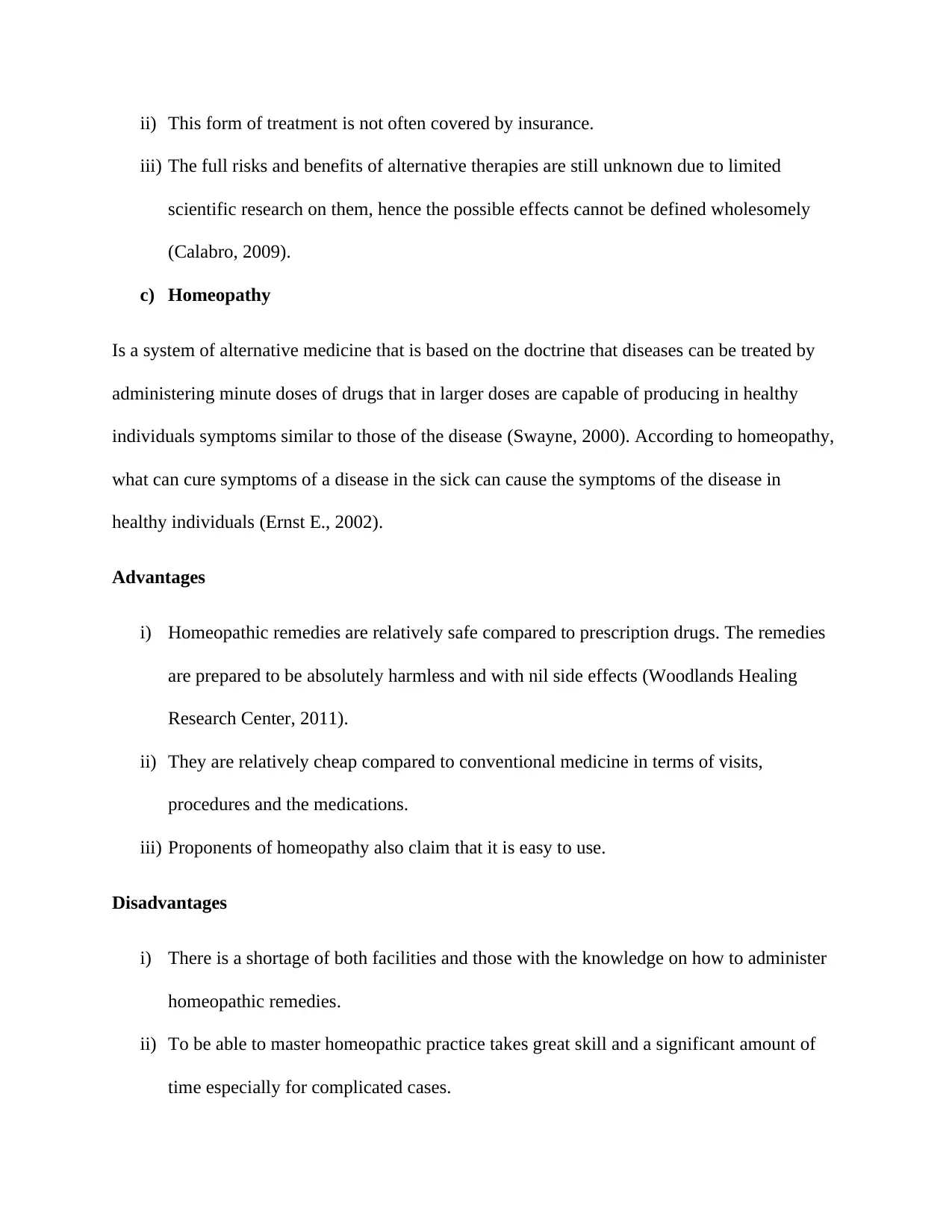
ii) This form of treatment is not often covered by insurance.
iii) The full risks and benefits of alternative therapies are still unknown due to limited
scientific research on them, hence the possible effects cannot be defined wholesomely
(Calabro, 2009).
c) Homeopathy
Is a system of alternative medicine that is based on the doctrine that diseases can be treated by
administering minute doses of drugs that in larger doses are capable of producing in healthy
individuals symptoms similar to those of the disease (Swayne, 2000). According to homeopathy,
what can cure symptoms of a disease in the sick can cause the symptoms of the disease in
healthy individuals (Ernst E., 2002).
Advantages
i) Homeopathic remedies are relatively safe compared to prescription drugs. The remedies
are prepared to be absolutely harmless and with nil side effects (Woodlands Healing
Research Center, 2011).
ii) They are relatively cheap compared to conventional medicine in terms of visits,
procedures and the medications.
iii) Proponents of homeopathy also claim that it is easy to use.
Disadvantages
i) There is a shortage of both facilities and those with the knowledge on how to administer
homeopathic remedies.
ii) To be able to master homeopathic practice takes great skill and a significant amount of
time especially for complicated cases.
iii) The full risks and benefits of alternative therapies are still unknown due to limited
scientific research on them, hence the possible effects cannot be defined wholesomely
(Calabro, 2009).
c) Homeopathy
Is a system of alternative medicine that is based on the doctrine that diseases can be treated by
administering minute doses of drugs that in larger doses are capable of producing in healthy
individuals symptoms similar to those of the disease (Swayne, 2000). According to homeopathy,
what can cure symptoms of a disease in the sick can cause the symptoms of the disease in
healthy individuals (Ernst E., 2002).
Advantages
i) Homeopathic remedies are relatively safe compared to prescription drugs. The remedies
are prepared to be absolutely harmless and with nil side effects (Woodlands Healing
Research Center, 2011).
ii) They are relatively cheap compared to conventional medicine in terms of visits,
procedures and the medications.
iii) Proponents of homeopathy also claim that it is easy to use.
Disadvantages
i) There is a shortage of both facilities and those with the knowledge on how to administer
homeopathic remedies.
ii) To be able to master homeopathic practice takes great skill and a significant amount of
time especially for complicated cases.
Paraphrase This Document
Need a fresh take? Get an instant paraphrase of this document with our AI Paraphraser
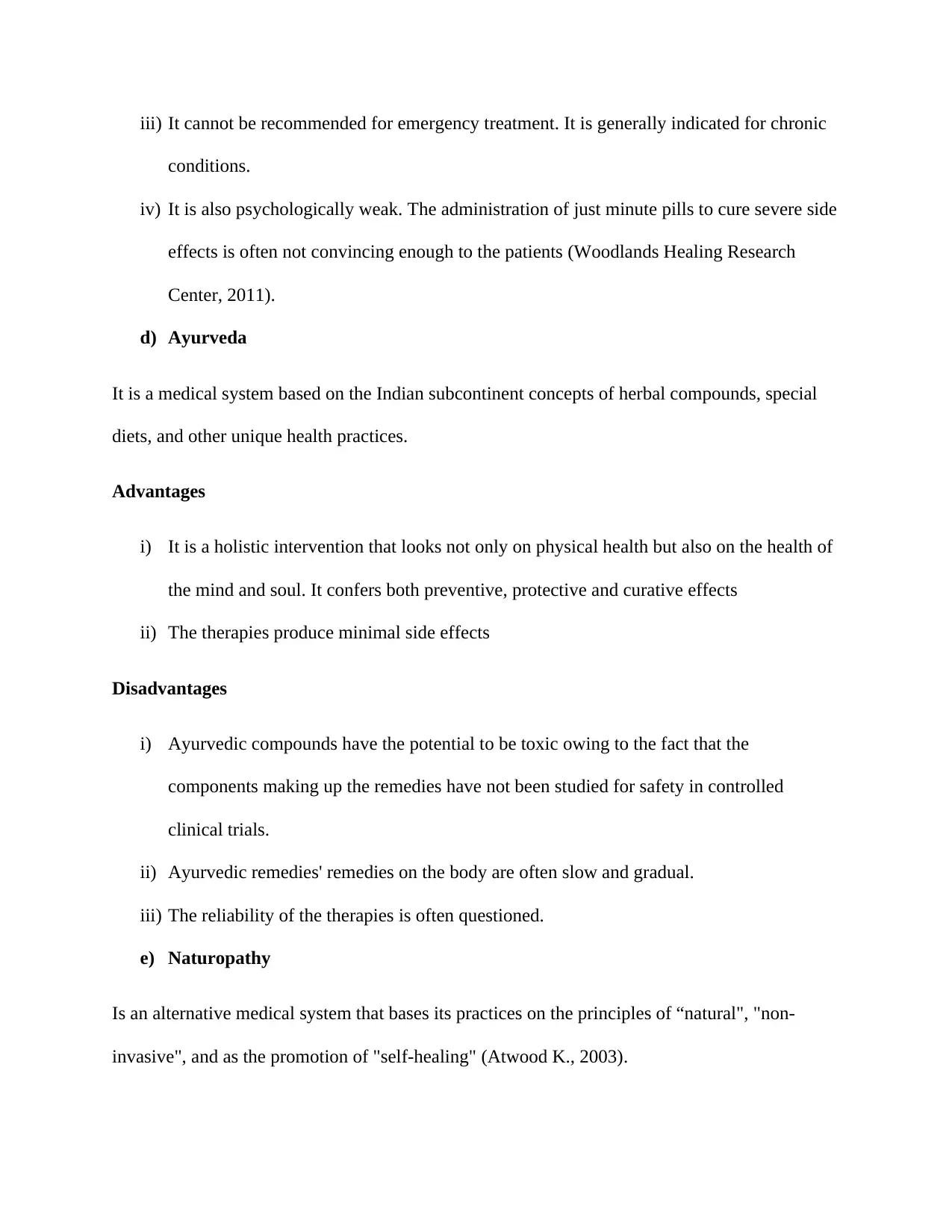
iii) It cannot be recommended for emergency treatment. It is generally indicated for chronic
conditions.
iv) It is also psychologically weak. The administration of just minute pills to cure severe side
effects is often not convincing enough to the patients (Woodlands Healing Research
Center, 2011).
d) Ayurveda
It is a medical system based on the Indian subcontinent concepts of herbal compounds, special
diets, and other unique health practices.
Advantages
i) It is a holistic intervention that looks not only on physical health but also on the health of
the mind and soul. It confers both preventive, protective and curative effects
ii) The therapies produce minimal side effects
Disadvantages
i) Ayurvedic compounds have the potential to be toxic owing to the fact that the
components making up the remedies have not been studied for safety in controlled
clinical trials.
ii) Ayurvedic remedies' remedies on the body are often slow and gradual.
iii) The reliability of the therapies is often questioned.
e) Naturopathy
Is an alternative medical system that bases its practices on the principles of “natural", "non-
invasive", and as the promotion of "self-healing" (Atwood K., 2003).
conditions.
iv) It is also psychologically weak. The administration of just minute pills to cure severe side
effects is often not convincing enough to the patients (Woodlands Healing Research
Center, 2011).
d) Ayurveda
It is a medical system based on the Indian subcontinent concepts of herbal compounds, special
diets, and other unique health practices.
Advantages
i) It is a holistic intervention that looks not only on physical health but also on the health of
the mind and soul. It confers both preventive, protective and curative effects
ii) The therapies produce minimal side effects
Disadvantages
i) Ayurvedic compounds have the potential to be toxic owing to the fact that the
components making up the remedies have not been studied for safety in controlled
clinical trials.
ii) Ayurvedic remedies' remedies on the body are often slow and gradual.
iii) The reliability of the therapies is often questioned.
e) Naturopathy
Is an alternative medical system that bases its practices on the principles of “natural", "non-
invasive", and as the promotion of "self-healing" (Atwood K., 2003).
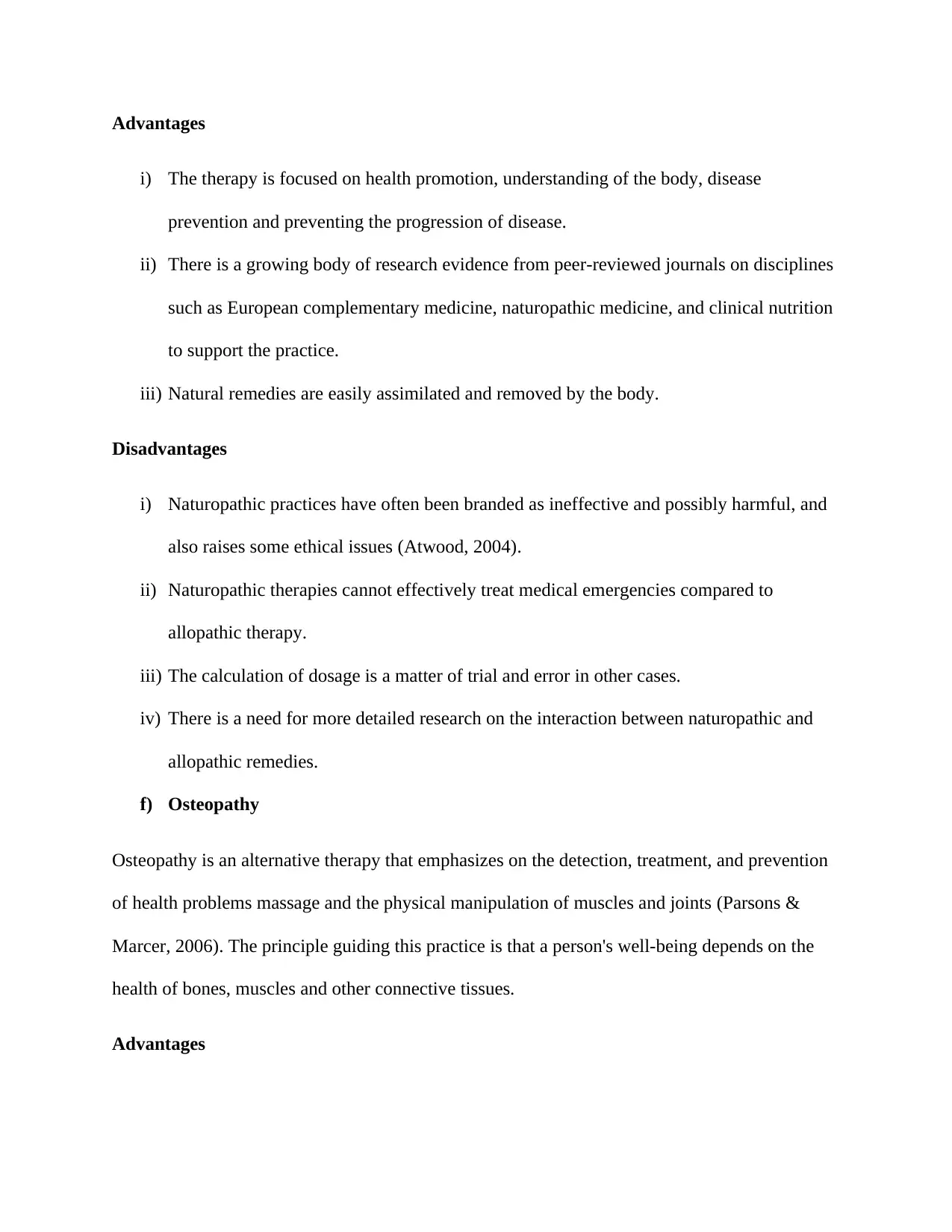
Advantages
i) The therapy is focused on health promotion, understanding of the body, disease
prevention and preventing the progression of disease.
ii) There is a growing body of research evidence from peer-reviewed journals on disciplines
such as European complementary medicine, naturopathic medicine, and clinical nutrition
to support the practice.
iii) Natural remedies are easily assimilated and removed by the body.
Disadvantages
i) Naturopathic practices have often been branded as ineffective and possibly harmful, and
also raises some ethical issues (Atwood, 2004).
ii) Naturopathic therapies cannot effectively treat medical emergencies compared to
allopathic therapy.
iii) The calculation of dosage is a matter of trial and error in other cases.
iv) There is a need for more detailed research on the interaction between naturopathic and
allopathic remedies.
f) Osteopathy
Osteopathy is an alternative therapy that emphasizes on the detection, treatment, and prevention
of health problems massage and the physical manipulation of muscles and joints (Parsons &
Marcer, 2006). The principle guiding this practice is that a person's well-being depends on the
health of bones, muscles and other connective tissues.
Advantages
i) The therapy is focused on health promotion, understanding of the body, disease
prevention and preventing the progression of disease.
ii) There is a growing body of research evidence from peer-reviewed journals on disciplines
such as European complementary medicine, naturopathic medicine, and clinical nutrition
to support the practice.
iii) Natural remedies are easily assimilated and removed by the body.
Disadvantages
i) Naturopathic practices have often been branded as ineffective and possibly harmful, and
also raises some ethical issues (Atwood, 2004).
ii) Naturopathic therapies cannot effectively treat medical emergencies compared to
allopathic therapy.
iii) The calculation of dosage is a matter of trial and error in other cases.
iv) There is a need for more detailed research on the interaction between naturopathic and
allopathic remedies.
f) Osteopathy
Osteopathy is an alternative therapy that emphasizes on the detection, treatment, and prevention
of health problems massage and the physical manipulation of muscles and joints (Parsons &
Marcer, 2006). The principle guiding this practice is that a person's well-being depends on the
health of bones, muscles and other connective tissues.
Advantages
⊘ This is a preview!⊘
Do you want full access?
Subscribe today to unlock all pages.

Trusted by 1+ million students worldwide
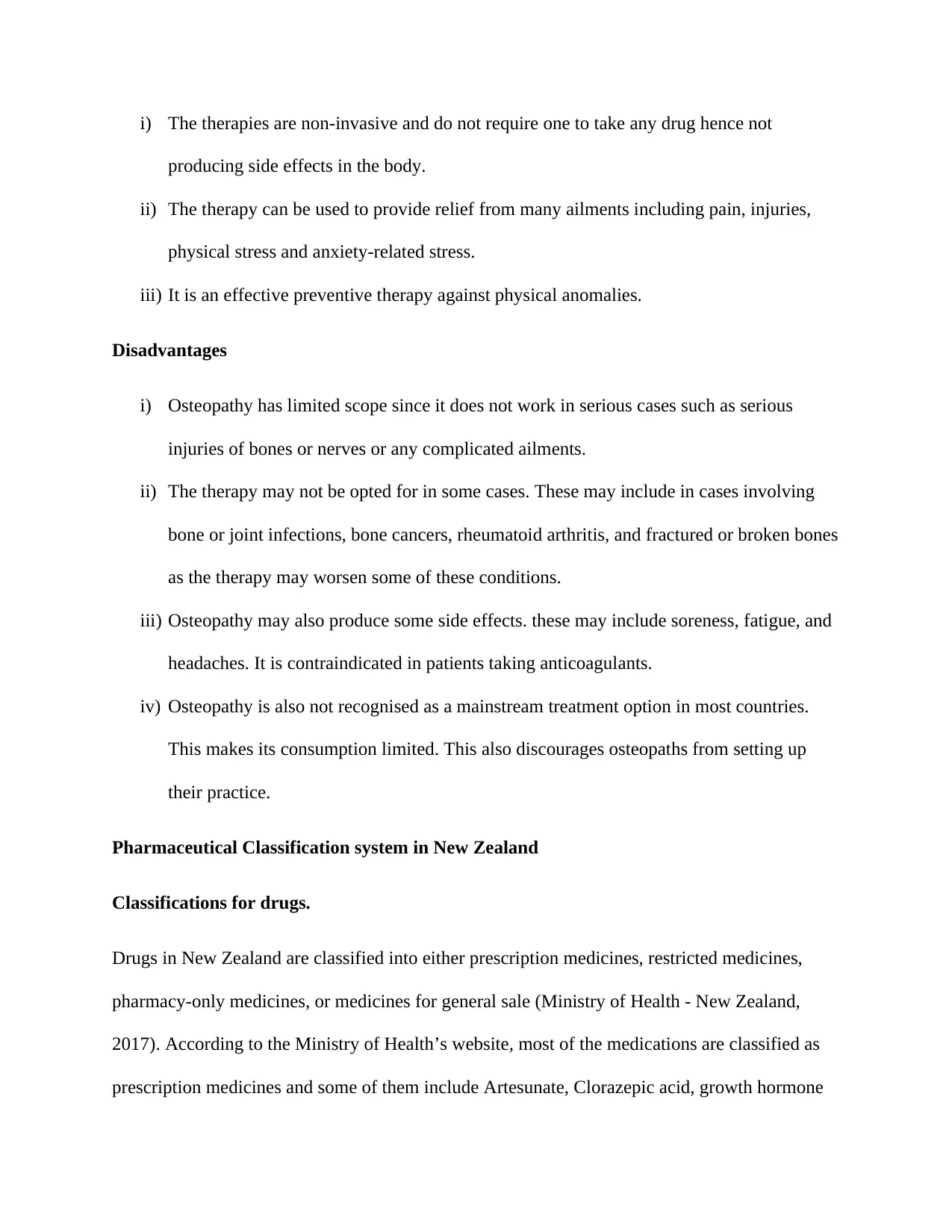
i) The therapies are non-invasive and do not require one to take any drug hence not
producing side effects in the body.
ii) The therapy can be used to provide relief from many ailments including pain, injuries,
physical stress and anxiety-related stress.
iii) It is an effective preventive therapy against physical anomalies.
Disadvantages
i) Osteopathy has limited scope since it does not work in serious cases such as serious
injuries of bones or nerves or any complicated ailments.
ii) The therapy may not be opted for in some cases. These may include in cases involving
bone or joint infections, bone cancers, rheumatoid arthritis, and fractured or broken bones
as the therapy may worsen some of these conditions.
iii) Osteopathy may also produce some side effects. these may include soreness, fatigue, and
headaches. It is contraindicated in patients taking anticoagulants.
iv) Osteopathy is also not recognised as a mainstream treatment option in most countries.
This makes its consumption limited. This also discourages osteopaths from setting up
their practice.
Pharmaceutical Classification system in New Zealand
Classifications for drugs.
Drugs in New Zealand are classified into either prescription medicines, restricted medicines,
pharmacy-only medicines, or medicines for general sale (Ministry of Health - New Zealand,
2017). According to the Ministry of Health’s website, most of the medications are classified as
prescription medicines and some of them include Artesunate, Clorazepic acid, growth hormone
producing side effects in the body.
ii) The therapy can be used to provide relief from many ailments including pain, injuries,
physical stress and anxiety-related stress.
iii) It is an effective preventive therapy against physical anomalies.
Disadvantages
i) Osteopathy has limited scope since it does not work in serious cases such as serious
injuries of bones or nerves or any complicated ailments.
ii) The therapy may not be opted for in some cases. These may include in cases involving
bone or joint infections, bone cancers, rheumatoid arthritis, and fractured or broken bones
as the therapy may worsen some of these conditions.
iii) Osteopathy may also produce some side effects. these may include soreness, fatigue, and
headaches. It is contraindicated in patients taking anticoagulants.
iv) Osteopathy is also not recognised as a mainstream treatment option in most countries.
This makes its consumption limited. This also discourages osteopaths from setting up
their practice.
Pharmaceutical Classification system in New Zealand
Classifications for drugs.
Drugs in New Zealand are classified into either prescription medicines, restricted medicines,
pharmacy-only medicines, or medicines for general sale (Ministry of Health - New Zealand,
2017). According to the Ministry of Health’s website, most of the medications are classified as
prescription medicines and some of them include Artesunate, Clorazepic acid, growth hormone
Paraphrase This Document
Need a fresh take? Get an instant paraphrase of this document with our AI Paraphraser
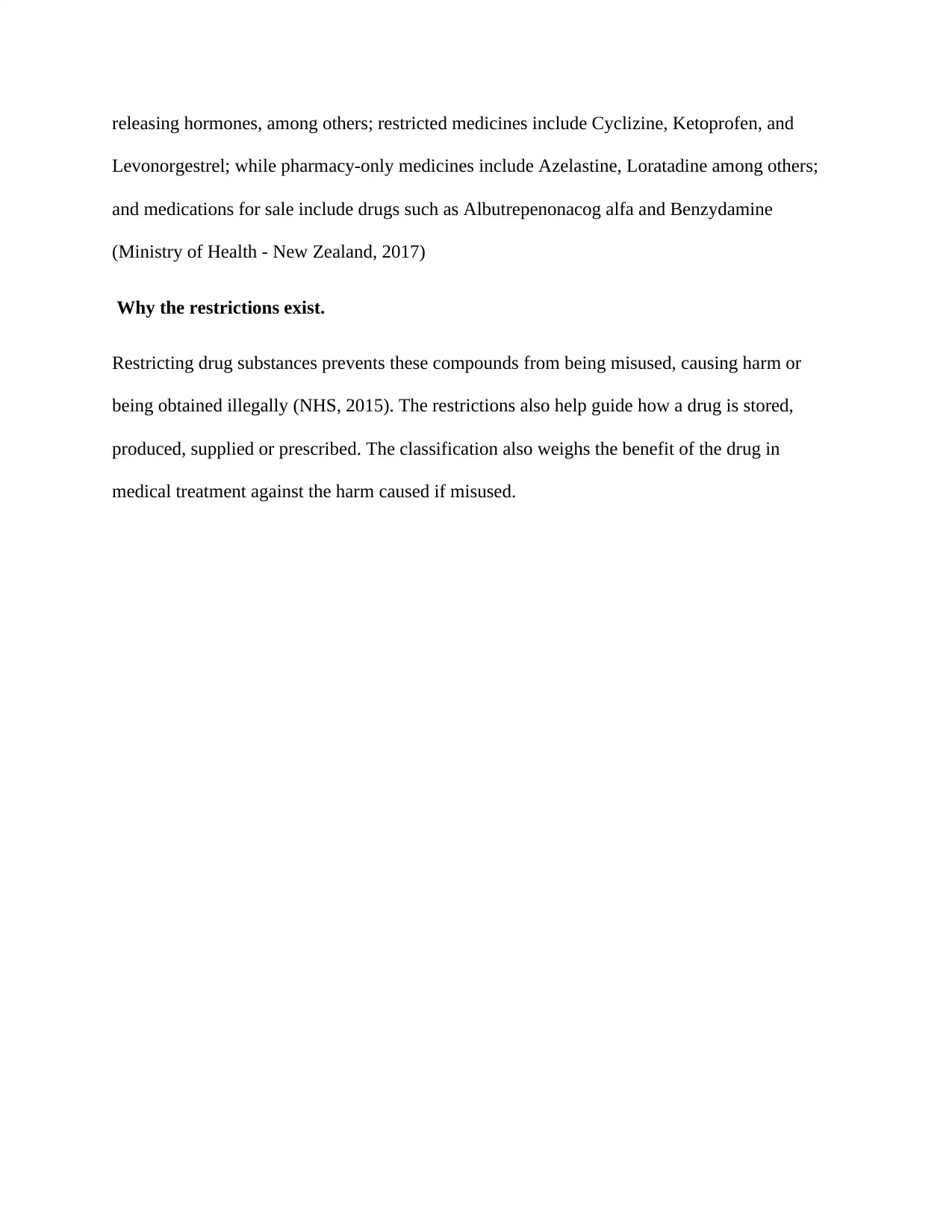
releasing hormones, among others; restricted medicines include Cyclizine, Ketoprofen, and
Levonorgestrel; while pharmacy-only medicines include Azelastine, Loratadine among others;
and medications for sale include drugs such as Albutrepenonacog alfa and Benzydamine
(Ministry of Health - New Zealand, 2017)
Why the restrictions exist.
Restricting drug substances prevents these compounds from being misused, causing harm or
being obtained illegally (NHS, 2015). The restrictions also help guide how a drug is stored,
produced, supplied or prescribed. The classification also weighs the benefit of the drug in
medical treatment against the harm caused if misused.
Levonorgestrel; while pharmacy-only medicines include Azelastine, Loratadine among others;
and medications for sale include drugs such as Albutrepenonacog alfa and Benzydamine
(Ministry of Health - New Zealand, 2017)
Why the restrictions exist.
Restricting drug substances prevents these compounds from being misused, causing harm or
being obtained illegally (NHS, 2015). The restrictions also help guide how a drug is stored,
produced, supplied or prescribed. The classification also weighs the benefit of the drug in
medical treatment against the harm caused if misused.
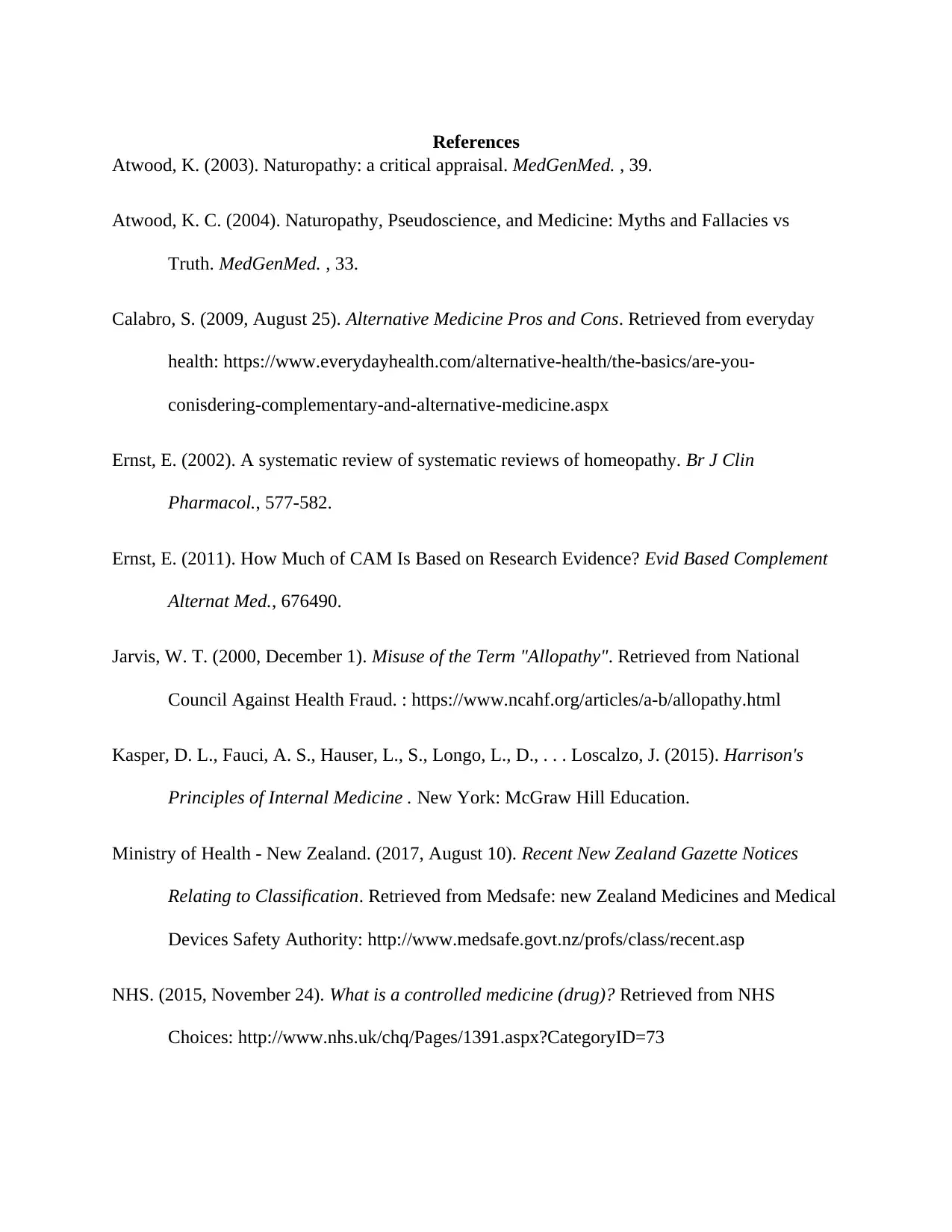
References
Atwood, K. (2003). Naturopathy: a critical appraisal. MedGenMed. , 39.
Atwood, K. C. (2004). Naturopathy, Pseudoscience, and Medicine: Myths and Fallacies vs
Truth. MedGenMed. , 33.
Calabro, S. (2009, August 25). Alternative Medicine Pros and Cons. Retrieved from everyday
health: https://www.everydayhealth.com/alternative-health/the-basics/are-you-
conisdering-complementary-and-alternative-medicine.aspx
Ernst, E. (2002). A systematic review of systematic reviews of homeopathy. Br J Clin
Pharmacol., 577-582.
Ernst, E. (2011). How Much of CAM Is Based on Research Evidence? Evid Based Complement
Alternat Med., 676490.
Jarvis, W. T. (2000, December 1). Misuse of the Term "Allopathy". Retrieved from National
Council Against Health Fraud. : https://www.ncahf.org/articles/a-b/allopathy.html
Kasper, D. L., Fauci, A. S., Hauser, L., S., Longo, L., D., . . . Loscalzo, J. (2015). Harrison's
Principles of Internal Medicine . New York: McGraw Hill Education.
Ministry of Health - New Zealand. (2017, August 10). Recent New Zealand Gazette Notices
Relating to Classification. Retrieved from Medsafe: new Zealand Medicines and Medical
Devices Safety Authority: http://www.medsafe.govt.nz/profs/class/recent.asp
NHS. (2015, November 24). What is a controlled medicine (drug)? Retrieved from NHS
Choices: http://www.nhs.uk/chq/Pages/1391.aspx?CategoryID=73
Atwood, K. (2003). Naturopathy: a critical appraisal. MedGenMed. , 39.
Atwood, K. C. (2004). Naturopathy, Pseudoscience, and Medicine: Myths and Fallacies vs
Truth. MedGenMed. , 33.
Calabro, S. (2009, August 25). Alternative Medicine Pros and Cons. Retrieved from everyday
health: https://www.everydayhealth.com/alternative-health/the-basics/are-you-
conisdering-complementary-and-alternative-medicine.aspx
Ernst, E. (2002). A systematic review of systematic reviews of homeopathy. Br J Clin
Pharmacol., 577-582.
Ernst, E. (2011). How Much of CAM Is Based on Research Evidence? Evid Based Complement
Alternat Med., 676490.
Jarvis, W. T. (2000, December 1). Misuse of the Term "Allopathy". Retrieved from National
Council Against Health Fraud. : https://www.ncahf.org/articles/a-b/allopathy.html
Kasper, D. L., Fauci, A. S., Hauser, L., S., Longo, L., D., . . . Loscalzo, J. (2015). Harrison's
Principles of Internal Medicine . New York: McGraw Hill Education.
Ministry of Health - New Zealand. (2017, August 10). Recent New Zealand Gazette Notices
Relating to Classification. Retrieved from Medsafe: new Zealand Medicines and Medical
Devices Safety Authority: http://www.medsafe.govt.nz/profs/class/recent.asp
NHS. (2015, November 24). What is a controlled medicine (drug)? Retrieved from NHS
Choices: http://www.nhs.uk/chq/Pages/1391.aspx?CategoryID=73
⊘ This is a preview!⊘
Do you want full access?
Subscribe today to unlock all pages.

Trusted by 1+ million students worldwide
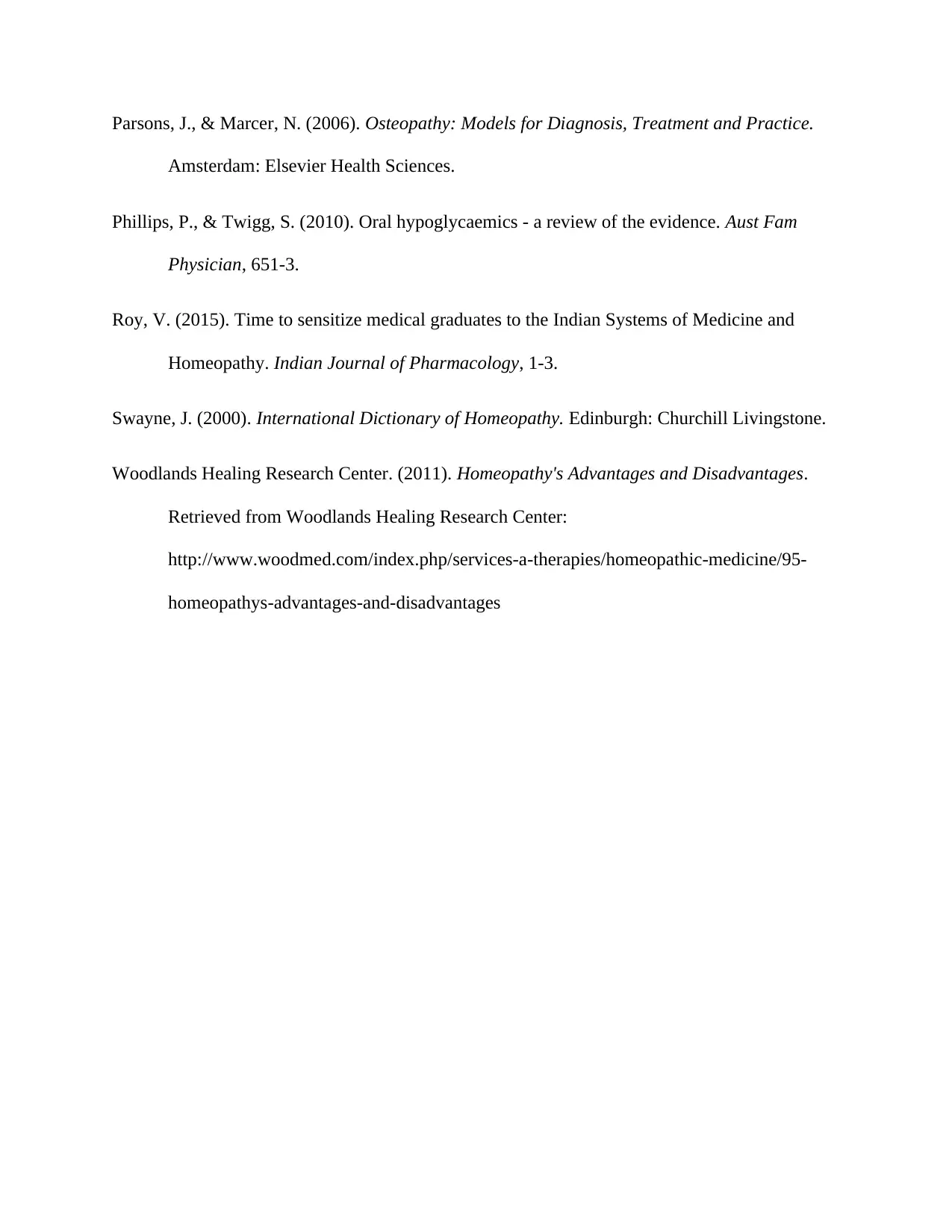
Parsons, J., & Marcer, N. (2006). Osteopathy: Models for Diagnosis, Treatment and Practice.
Amsterdam: Elsevier Health Sciences.
Phillips, P., & Twigg, S. (2010). Oral hypoglycaemics - a review of the evidence. Aust Fam
Physician, 651-3.
Roy, V. (2015). Time to sensitize medical graduates to the Indian Systems of Medicine and
Homeopathy. Indian Journal of Pharmacology, 1-3.
Swayne, J. (2000). International Dictionary of Homeopathy. Edinburgh: Churchill Livingstone.
Woodlands Healing Research Center. (2011). Homeopathy's Advantages and Disadvantages.
Retrieved from Woodlands Healing Research Center:
http://www.woodmed.com/index.php/services-a-therapies/homeopathic-medicine/95-
homeopathys-advantages-and-disadvantages
Amsterdam: Elsevier Health Sciences.
Phillips, P., & Twigg, S. (2010). Oral hypoglycaemics - a review of the evidence. Aust Fam
Physician, 651-3.
Roy, V. (2015). Time to sensitize medical graduates to the Indian Systems of Medicine and
Homeopathy. Indian Journal of Pharmacology, 1-3.
Swayne, J. (2000). International Dictionary of Homeopathy. Edinburgh: Churchill Livingstone.
Woodlands Healing Research Center. (2011). Homeopathy's Advantages and Disadvantages.
Retrieved from Woodlands Healing Research Center:
http://www.woodmed.com/index.php/services-a-therapies/homeopathic-medicine/95-
homeopathys-advantages-and-disadvantages
1 out of 10
Related Documents
Your All-in-One AI-Powered Toolkit for Academic Success.
+13062052269
info@desklib.com
Available 24*7 on WhatsApp / Email
![[object Object]](/_next/static/media/star-bottom.7253800d.svg)
Unlock your academic potential
Copyright © 2020–2025 A2Z Services. All Rights Reserved. Developed and managed by ZUCOL.





